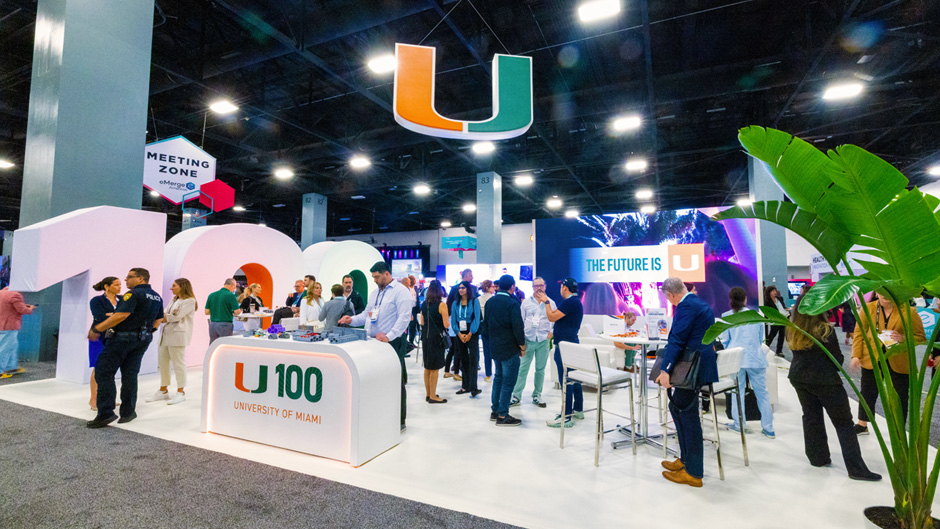Wilted cilantro leaves and a mushy onion in the dorm room refrigerator of University of Miami student Deceli Soto inspired her to develop an AI-powered app that not only ensures food won’t go to waste but also helps feed the hungry.
“Food waste is a $200 billion problem,” said the 21-year-old software engineering major from Coral Springs, Florida. “The average American family throws out more than $1,500 of food each year. Multiply that by millions of households, and it’s a huge concern.”
Using scans of a customer’s grocery receipts combined with images of the food they purchase, R.I.P.E., or Real-time Insights on Produce Expiration, holds the promise of ensuring food won’t find its way into the waste disposal, placing grocery items into a virtual refrigerator and text alerts on when a consumer’s apples, avocados, asparagus, and other produce is about to expire.
“Hey, your bread is about to spoil in a week. Make a sandwich. Or your bananas are about to go bad. Have one today as a snack. That’s what we envision our app doing,” said Jenna Viard, another College of Engineering student who teamed with Soto and classmates Ivy Enyenihi and Jailyn Mathews to develop R.I.P.E.
The app, still in the development phase, took the top prize in the environment and conservation category of the recent Horizon AI Hackathon held on the University of Miami campus.
The app also captured first-place honors in the Solve for Miami competition sponsored by eMerge Americas. And on Thursday, with family members, friends, and their College of Engineering mentor, Lokesh Ramamoorthi, supporting them, the four students received a $5,000 check from Melissa Medina, eMerge cofounder, CEO, and president, that will go to help further develop R.I.P.E. Miami-Dade Mayor Daniella Levine Cava, who recently opened the University’s Resilience 365 summit, participated in the check presentation.
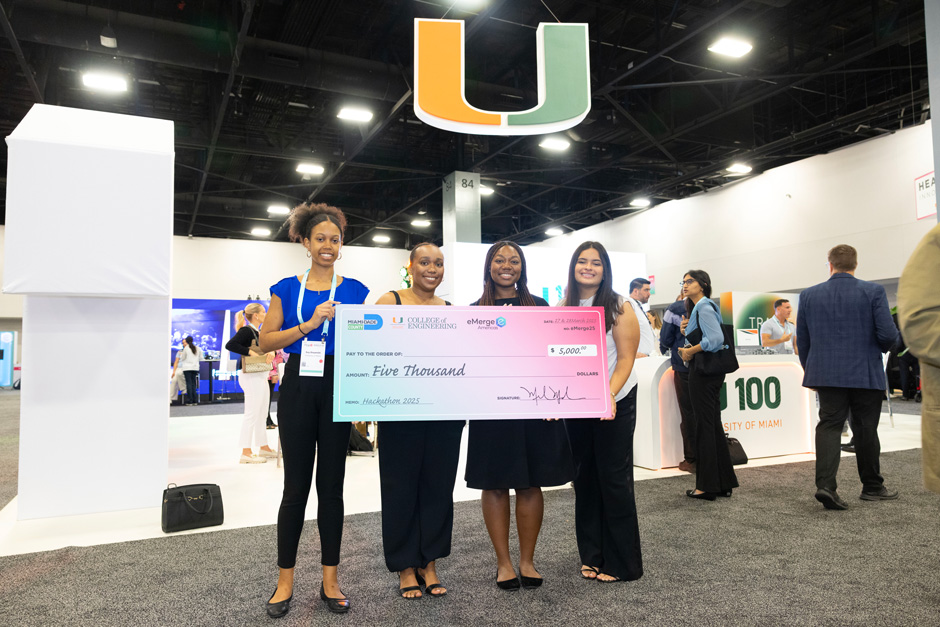
It was one of the opening-day highlights of the two-day technology conference, which features keynote speakers, live workshops, and interactive exhibits.
As in previous years, the University of Miami had a strong presence at the event, with researchers, students, and other representatives from its various schools and colleges discussing their creative prototypes at the institution’s eMerge booth, organized by U Innovation, and led by Norma Kenyon, vice provost for innovation.
Olivia Lightfuss, a cancer biology Ph.D. candidate at the Miller School of Medicine, updated conference-goers on the work she is conducting as a recipient of a Research Commercialization Fellowship, a Wallace H. Coulter Center for Translational Research program that exposes graduate and medical students to the business of bioscience.
“I’m looking at a novel target in lymphoma and then working on characterizing that target and developing drugs against it, which can eventually be brought to a clinical setting,” she said. “Specifically, with diffuse large B-cell lymphoma, up to 40 percent of patients are relapsed or refractory. So, there’s a huge unmet need. And that’s why this research is important, as it attempts to meet that need with new therapeutic options.”
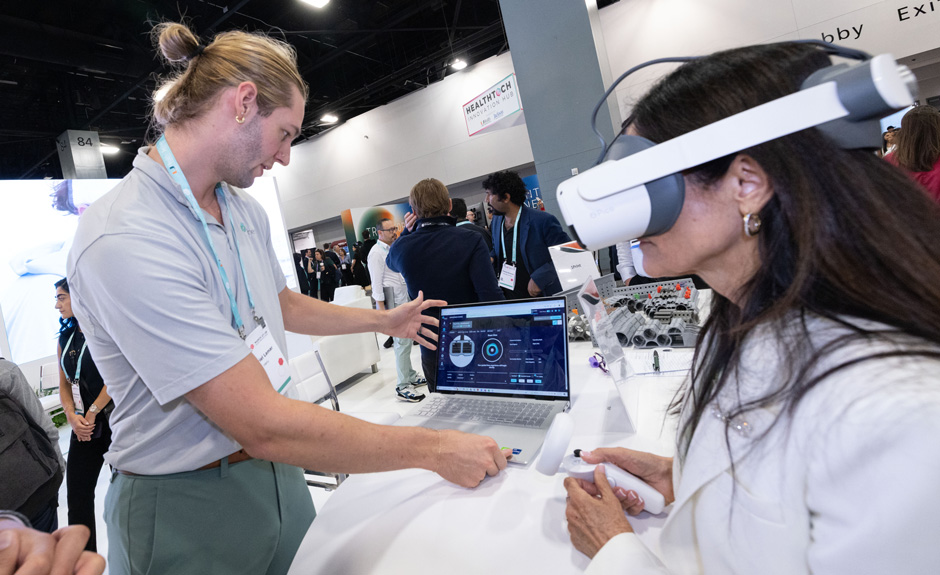
During one of several presentations held throughout the day on the UHealth – University of Miami Health System stage, actors demonstrated for onlookers the “fantastic voyage” that could some become reality for patients at Bascom Palmer Eye Institute.
Through a VR headset currently under development, patients will be able to take an immersive journey through their eyes, examining with a physician their cornea, pupil, retina, blood vessels, and other vital structures of the organ.
“It feels like I’m looking through a camera,” said Tony, a patient actor, as he simulated the experience of what he was seeing through the headset.
“This is all part of leveraging technology to better understand better what’s happening in our patients’ eyes,” Dr. Giselle Ricur, ophthalmologist and digital health specialist at Bascom, told the audience.
“One in 10 Americans have the early form of age-related macular degeneration. AI is getting to the point that we’ll be able to detect the condition in time to prevent blindness,” she said, noting that Bascom researchers are combing virtual reality, augmented reality, and AI to advance better outcomes for patients and to teach tomorrow’s ophthalmologists.
One type of VR headset, Ricur noted, is already in use at Bascom—a headset patients put on to get a comprehensive examination of their eyes, including the critical visual field test. And medical students, she added, are also slipping on VR headsets to learn in replicated classroom environments.
“But we’re only at the tip of the iceberg,” she said, characterizing the future of medicine as “amazing.”
Later on Thursday, Paul Pavlou, dean of the Miami Herbert Business School, led a mainstage talk called “AI as the new Co-Founder: The future of Entrepreneurship,” where he spoke about the power of utilizing artificial intelligence tools to make businesses more productive. He said AI can make business leaders more productive in areas such as human resources, market research, as well as to help them manage workflows, finances, and cashflows.
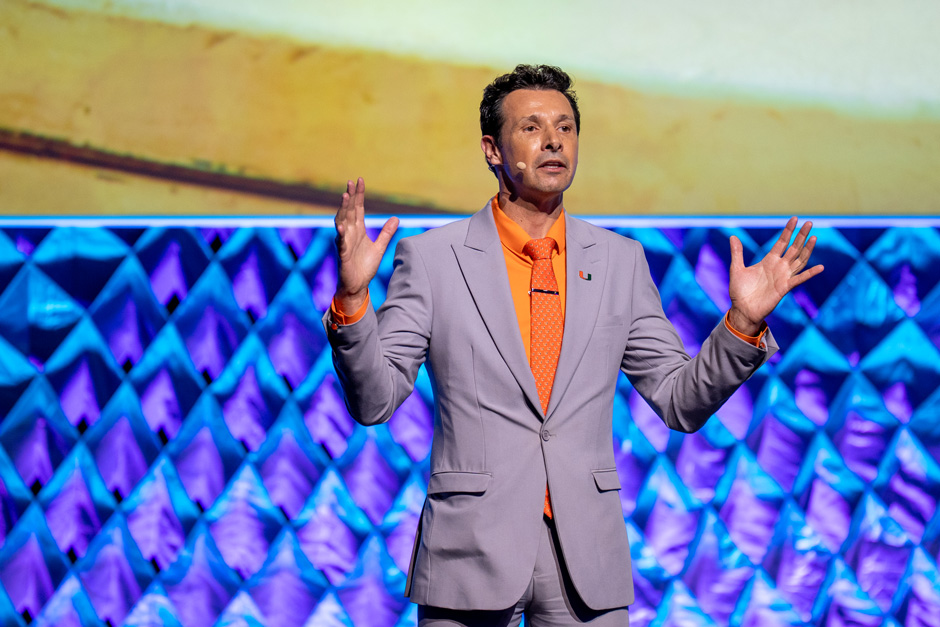
“People always ask me, ‘Will AI take my job?’ ” said Pavlou. “But in my opinion, if you want to be successful, and effective, and productive, learn to use AI.”
He went on to describe the effectiveness of the new technology: “Imagine a visionary co-founder who never takes breaks, can analyze billions of files of data in a few seconds, and who can conduct market research, get the right information, segment the market, and personalize everything—this is all possible using AI.”
He also touted how Miami Herbert Business School faculty members are integrating more than 280 AI tools in their classes.
“We are teaching students how to embed AI agents and use them to facilitate processes, or automate products,” he said. “Ultimately, this can help them become better at running their companies.”
In other displays at the University’s eMerge space, the health of coral reefs, which are increasingly under threat from bleaching events, was explored. Prannoy Suraneni, an associate professor in the Department of Civil and Architectural Engineering, detailed how innovative 3D-printed hybrid reefs have been submerged 1,000 feet offshore of North Beach Oceanside Park to test their ability to protect the coastline from rising sea levels and storm surge.
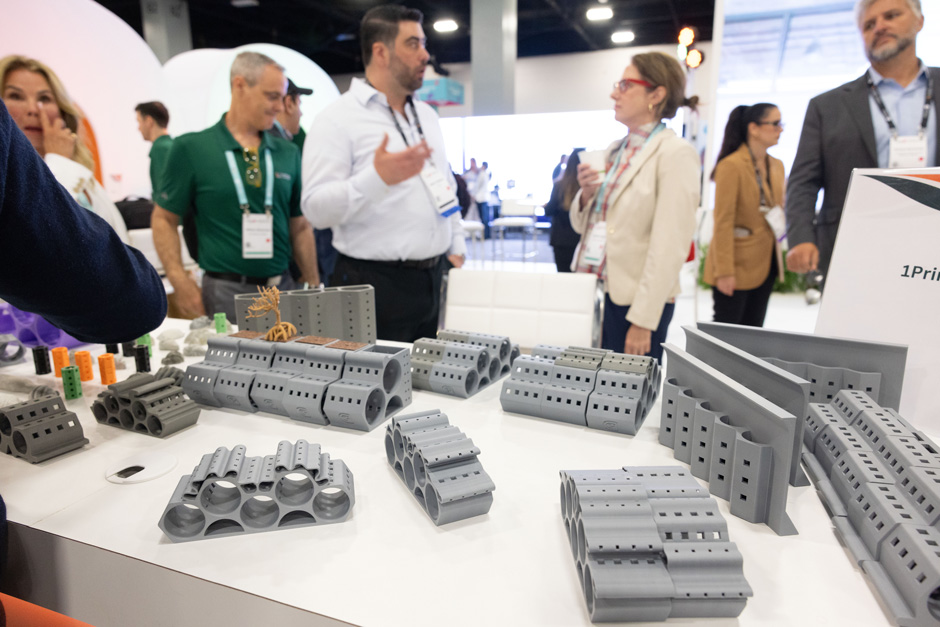
The so-called SEAHIVE structures have also been deployed at an underwater marine park in Pompano Beach. 1Print, the Pompano Beach-based 3D printing infrastructure and construction company that has 3D printed the structures for Suraneni and his team, is also planning other deployments, according to the firm’s cofounder, Adam Friedman.
“Our method saves time on manufacturing and deployment and is safer,” said Friedman, praising his company’s collaboration with the College of Engineering.
One of the most critical tests of their effectives of SEAHIVE will be conducted in the coming months, when researchers from the Rosenstiel School of Marine, Atmospheric, and Earth Science will attempt to plant living corals on the hybrid reefs.
At another time, Ansh Bhatt, an MD/MBA student at the Miller School of Medicine and the Miami Herbert Business School, was networking with tech entrepreneurs as he works to expand his startup, ChargeBay. He and his co-founder came up with the idea a few years ago to create a software that makes it cheaper for property owners to install public electric vehicle charging stations in commercial buildings or apartment buildings. This would help property owners to offset the added electricity costs. But through The Launch Pad at the University, Bhatt said he has improved his business plan, and now has a few clients. He was glad to meet many others in the field at eMerge.
“Seeing the diversity of companies here that can relate to my startup is really cool, and it’s been great to make connections here,” Bhatt added.
Other highlights during the day included Dr. Pankaj Agrawal from Project Newborn at the Miller School presenting on “How genomics is transforming the diagnosis of rare diseases in children;” University alumnus Jaret Davis, senior vice president of Greenberg Traurig, who presented “Fueling Florida’s rise as a global tech powerhouse;” Azizi Seixas, interim inaugural chair of the Department of Informatics and Health Data Science at the Miller School, presenting on “Miami’s blueprint for health tech leadership;” and Michael Berkowitz, executive director of the University’s Climate Resilience Institute, speaking on “University-industry collaborations for resilient economic growth.”

